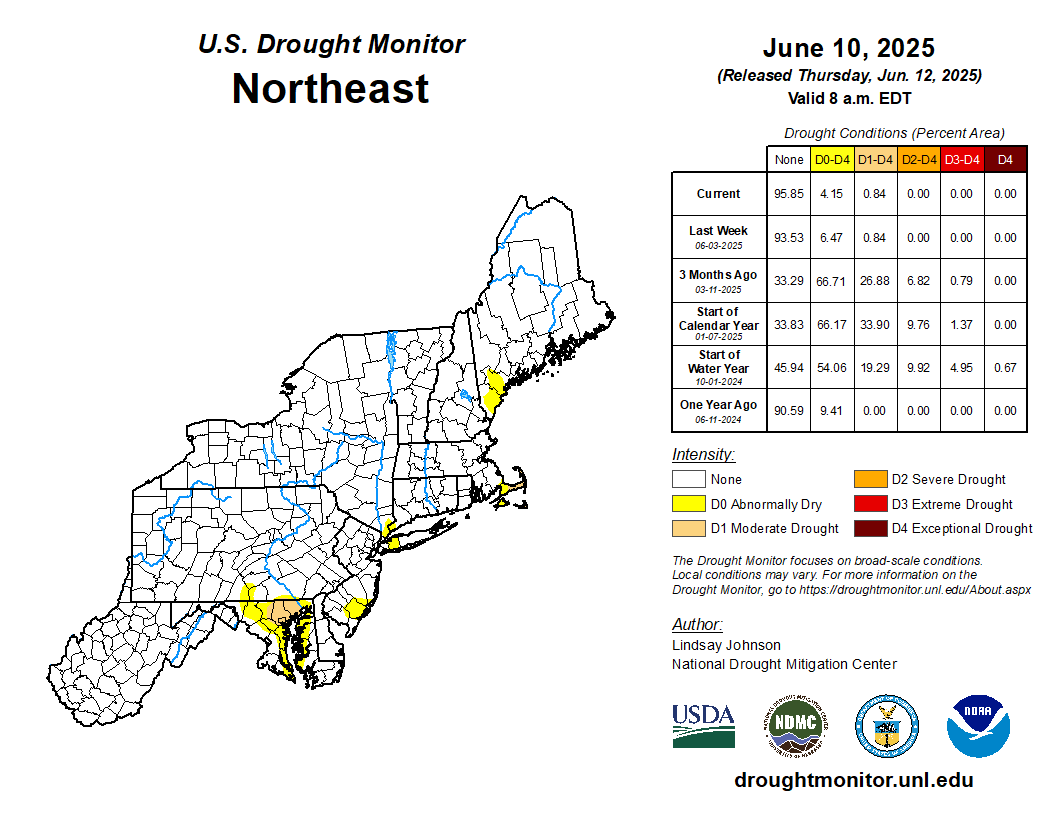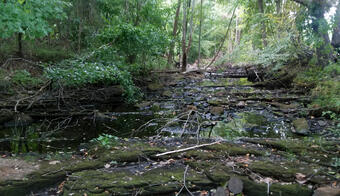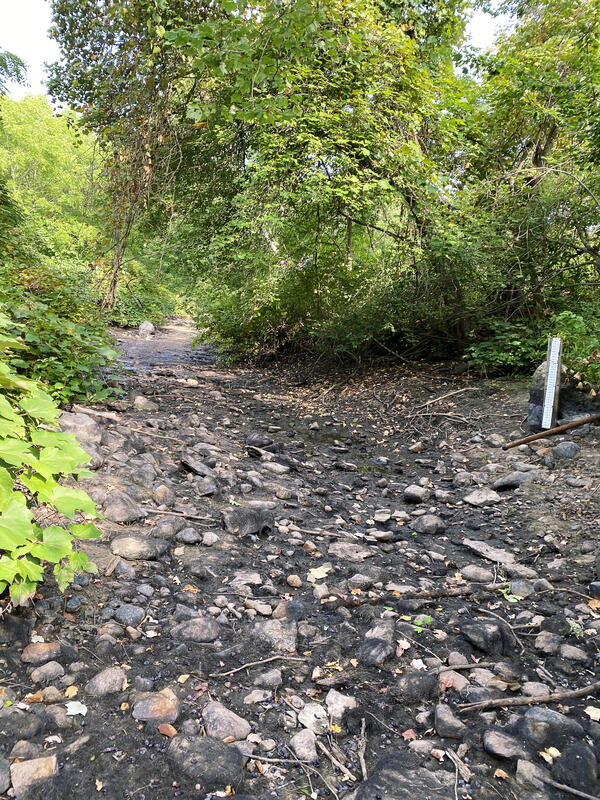The New England Water Science Center continuously monitors the status of New England's principal rivers, reservoirs, and aquifers to compare current hydrologic conditions with normal and extreme recorded values. Displayed on the photo is a drought impact on Cochituate Brook at Framingham, Massachusetts.
Droughts are one of the most expensive and damaging hydrologic hazards in the United States. They are generally slow in developing, frequently occur over a long period of time, and can affect large areas and populations.
The U.S. Geological Survey New England Water Science Center's long-term continuous monitoring network of surface water and groundwater stations provide data to define drought severity. The New England Water Science Center continuously monitors the status of New England's principal rivers, reservoirs, and aquifers to compare current hydrologic conditions with normal and extreme recorded values.
Current Drought Conditions in the Northeastern United States


USGS Drought Information
Streamflow
USGS New England WaterWatch streamflow maps showing:
-
Current real-time streamflow
-
Daily average streamflow
-
7-day average streamflow
-
14-day average streamflow
-
28-day average streamflow
-
Monthly average streamflow
USGS WaterWatch State Dashboard – real-time streamflow conditions
Groundwater
Groundwater Levels in New England
National Water Dashboard for New England – real-time groundwater levels
* USGS real-time data used to produce these maps are provisional and subject to revision until they are thoroughly reviewed and receive final approval.
Monthly Hydrologic Conditions in New England (Current Conditions)
Drought Forecasting: Streamflow and Groundwater Probabilities

Other Drought Related Maps and Information
-
National Integrated Drought Information System (NIDIS) – National Current Conditions
New England State Drought Information
Historical Droughts in New England
- 2020 Drought
- Northeast Drought of 2016-17
- Massachusetts Drought Retrospective 2016 - 2017
-
USGS National Water Summary 1988-89 – Hydrologic events floods and droughts (Individual State information)
Below are other science projects associated with this project.
New England Drought, 2020
Towards Understanding the Impact of Drought on the Arsenic Hazard for the Private Domestic Well Population in the United States
Below are data or web applications associated with this project.
New England Below Normal 28-day average streamflow compared to historical streamflow for the day of year
Below Normal 28-day average streamflow compared to historical streamflow for the day of year
Drought Streamflow Probabilities in Northeast Region
Maximum likelihood logistic regression (MLLR) is used to estimate drought probabilities for selected Northeast rivers and streams. Winter streamflows are used to estimate the chance of hydrologic drought during summer months. This application allows the display and query of these drought streamflow probabilities for Northeastern streams.

The New England Water Science Center continuously monitors the status of New England's principal rivers, reservoirs, and aquifers to compare current hydrologic conditions with normal and extreme recorded values. Displayed on the photo is a drought impact on Cochituate Brook at Framingham, Massachusetts.



Station 01196588 Mill River at Cook Hill Rd. in Cheshire, Connecticut.
Photo shows dry river channel at location of staff gage.
Station 01196588 Mill River at Cook Hill Rd. in Cheshire, Connecticut.
Photo shows dry river channel at location of staff gage.



Quinebaug River near West Thompson, Connecticut. Photo shows one of few deeper pools of water in the 01124151 station vicinity during drought.
Quinebaug River near West Thompson, Connecticut. Photo shows one of few deeper pools of water in the 01124151 station vicinity during drought.

Station 01124151 Quinebaug River West Thompson Connecticut. The photo shows the orifice line that senses the river stage. The orifice is out of water, so we were not able to collect stage or discharge data.
Station 01124151 Quinebaug River West Thompson Connecticut. The photo shows the orifice line that senses the river stage. The orifice is out of water, so we were not able to collect stage or discharge data.
Below are publications associated with this project.
2022 drought in New England
Forecasting drought probabilities for streams in the northeastern United States
Meeting the challenge: U.S. Geological Survey North Atlantic and Appalachian Region fiscal year 2020 in review
2020 drought in New England
Enhancement of primary production during drought in a temperate watershed is greater in larger rivers than headwater streams
Tropical river suspended sediment and solute dynamics in storms during an extreme drought
Flood- and drought-related natural hazards activities of the U.S. Geological Survey in New England
Hydrologic Drought Decision Support System (HyDroDSS)
Drought conditions in Maine, 1999-2002: A historical perspective
Below are data or web applications associated with this project.
Groundwater Levels in New England
View recent monthly and daily groundwater levels in New England relative to long-term monthly statistics.
WaterWatch Toolkit
The USGS WaterWatch Toolkit provides online tools that allow users to search USGS sites in various ways; create a variety of maps, graphs, charts, animations, and tables; perform a variety of streamflow analyses, and retrieve summary statistics.
Below are software products associated with this project.
HyDroDSS: Hydrologic Drought Decision Support System - Software page
The HyDroDSS is designed to provide water managers with risk-based information for balancing water-supply needs and aquatic-habitat protection goals to mitigate potential effects of hydrologic drought.
Below are FAQ associated with this project.
What causes drought?
A drought is a period of drier-than-normal conditions that results in water-related problems. The amount of precipitation at a particular location varies from year to year, but over a period of years the average amount is fairly constant. In the deserts of the Southwest, the average precipitation is less than 3 inches per year. In contrast, the average precipitation in the Northwest is more than...
When does a drought begin and end?
The beginning of a drought is difficult to determine. Several weeks, months, or even years might pass before people know that a drought is occurring. The end of a drought can occur as gradually as it began. The first evidence of drought is usually seen in records of rainfall. Within a short period of time, the amount of moisture in soils can begin to decrease. The effects of a drought on flow in...
Where in the Nation are droughts or very low flows occurring now? How can I see these sites on a map and get to the data?
To view the USGS streamflow information on drought, see the drought map on our WaterWatch site, which shows below-normal, 7-day average streamflow compared to historical streamflow for the United States. Links to additional maps and drought data are listed on the USGS Drought website and the National Integrated Drought Information System (NIDIS) .
Why doesn't a drought end when it rains?
Rainfall in any form will provide some drought relief. A good analogy might be how medicine and illness relate to each other. A single dose of medicine can alleviate symptoms of illness, but it usually takes a sustained program of medication to cure an illness. Likewise, a single rainstorm will not break the drought, but it might provide temporary relief. A light to moderate shower will probably...
Droughts are one of the most expensive and damaging hydrologic hazards in the United States. They are generally slow in developing, frequently occur over a long period of time, and can affect large areas and populations.
The U.S. Geological Survey New England Water Science Center's long-term continuous monitoring network of surface water and groundwater stations provide data to define drought severity. The New England Water Science Center continuously monitors the status of New England's principal rivers, reservoirs, and aquifers to compare current hydrologic conditions with normal and extreme recorded values.
Current Drought Conditions in the Northeastern United States


USGS Drought Information
Streamflow
USGS New England WaterWatch streamflow maps showing:
-
Current real-time streamflow
-
Daily average streamflow
-
7-day average streamflow
-
14-day average streamflow
-
28-day average streamflow
-
Monthly average streamflow
USGS WaterWatch State Dashboard – real-time streamflow conditions
Groundwater
Groundwater Levels in New England
National Water Dashboard for New England – real-time groundwater levels
* USGS real-time data used to produce these maps are provisional and subject to revision until they are thoroughly reviewed and receive final approval.
Monthly Hydrologic Conditions in New England (Current Conditions)
Drought Forecasting: Streamflow and Groundwater Probabilities

Other Drought Related Maps and Information
-
National Integrated Drought Information System (NIDIS) – National Current Conditions
New England State Drought Information
Historical Droughts in New England
- 2020 Drought
- Northeast Drought of 2016-17
- Massachusetts Drought Retrospective 2016 - 2017
-
USGS National Water Summary 1988-89 – Hydrologic events floods and droughts (Individual State information)
Below are other science projects associated with this project.
New England Drought, 2020
Towards Understanding the Impact of Drought on the Arsenic Hazard for the Private Domestic Well Population in the United States
Below are data or web applications associated with this project.
New England Below Normal 28-day average streamflow compared to historical streamflow for the day of year
Below Normal 28-day average streamflow compared to historical streamflow for the day of year
Drought Streamflow Probabilities in Northeast Region
Maximum likelihood logistic regression (MLLR) is used to estimate drought probabilities for selected Northeast rivers and streams. Winter streamflows are used to estimate the chance of hydrologic drought during summer months. This application allows the display and query of these drought streamflow probabilities for Northeastern streams.

The New England Water Science Center continuously monitors the status of New England's principal rivers, reservoirs, and aquifers to compare current hydrologic conditions with normal and extreme recorded values. Displayed on the photo is a drought impact on Cochituate Brook at Framingham, Massachusetts.
The New England Water Science Center continuously monitors the status of New England's principal rivers, reservoirs, and aquifers to compare current hydrologic conditions with normal and extreme recorded values. Displayed on the photo is a drought impact on Cochituate Brook at Framingham, Massachusetts.



Station 01196588 Mill River at Cook Hill Rd. in Cheshire, Connecticut.
Photo shows dry river channel at location of staff gage.
Station 01196588 Mill River at Cook Hill Rd. in Cheshire, Connecticut.
Photo shows dry river channel at location of staff gage.



Quinebaug River near West Thompson, Connecticut. Photo shows one of few deeper pools of water in the 01124151 station vicinity during drought.
Quinebaug River near West Thompson, Connecticut. Photo shows one of few deeper pools of water in the 01124151 station vicinity during drought.

Station 01124151 Quinebaug River West Thompson Connecticut. The photo shows the orifice line that senses the river stage. The orifice is out of water, so we were not able to collect stage or discharge data.
Station 01124151 Quinebaug River West Thompson Connecticut. The photo shows the orifice line that senses the river stage. The orifice is out of water, so we were not able to collect stage or discharge data.
Below are publications associated with this project.
2022 drought in New England
Forecasting drought probabilities for streams in the northeastern United States
Meeting the challenge: U.S. Geological Survey North Atlantic and Appalachian Region fiscal year 2020 in review
2020 drought in New England
Enhancement of primary production during drought in a temperate watershed is greater in larger rivers than headwater streams
Tropical river suspended sediment and solute dynamics in storms during an extreme drought
Flood- and drought-related natural hazards activities of the U.S. Geological Survey in New England
Hydrologic Drought Decision Support System (HyDroDSS)
Drought conditions in Maine, 1999-2002: A historical perspective
Below are data or web applications associated with this project.
Groundwater Levels in New England
View recent monthly and daily groundwater levels in New England relative to long-term monthly statistics.
WaterWatch Toolkit
The USGS WaterWatch Toolkit provides online tools that allow users to search USGS sites in various ways; create a variety of maps, graphs, charts, animations, and tables; perform a variety of streamflow analyses, and retrieve summary statistics.
Below are software products associated with this project.
HyDroDSS: Hydrologic Drought Decision Support System - Software page
The HyDroDSS is designed to provide water managers with risk-based information for balancing water-supply needs and aquatic-habitat protection goals to mitigate potential effects of hydrologic drought.
Below are FAQ associated with this project.
What causes drought?
A drought is a period of drier-than-normal conditions that results in water-related problems. The amount of precipitation at a particular location varies from year to year, but over a period of years the average amount is fairly constant. In the deserts of the Southwest, the average precipitation is less than 3 inches per year. In contrast, the average precipitation in the Northwest is more than...
When does a drought begin and end?
The beginning of a drought is difficult to determine. Several weeks, months, or even years might pass before people know that a drought is occurring. The end of a drought can occur as gradually as it began. The first evidence of drought is usually seen in records of rainfall. Within a short period of time, the amount of moisture in soils can begin to decrease. The effects of a drought on flow in...
Where in the Nation are droughts or very low flows occurring now? How can I see these sites on a map and get to the data?
To view the USGS streamflow information on drought, see the drought map on our WaterWatch site, which shows below-normal, 7-day average streamflow compared to historical streamflow for the United States. Links to additional maps and drought data are listed on the USGS Drought website and the National Integrated Drought Information System (NIDIS) .
Why doesn't a drought end when it rains?
Rainfall in any form will provide some drought relief. A good analogy might be how medicine and illness relate to each other. A single dose of medicine can alleviate symptoms of illness, but it usually takes a sustained program of medication to cure an illness. Likewise, a single rainstorm will not break the drought, but it might provide temporary relief. A light to moderate shower will probably...







